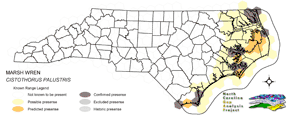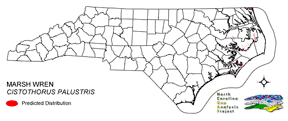
| Taxa: |
| Order: |
| Family: |
| Aves |
| Passeriformes |
| Troglodytidae |
| NatureServe Global Rank: |
| NatureServe State (NC) Rank: |
| G5 |
| S4B,S4N |
| Federal Status: |
| NC State Status: |
| --- |
| --- |


| Land Unit |
| US Fish & Wildlife Service |
| US Forest Service |
| US National Park Service |
| US Department of Defense |
| NC State Parks |
| NC University System |
| NC Wildlife Res. Com. |
| NC Forest Service |
| NC Div. of Coastal Mgmt. |
| Local Governments |
| Non-Governmental Org. |
| Other Public Lands |
| Private Lands |
| GAP Status 1-2 |
| All Protected Lands |
| Statewide |
| Hectares |
| 20,444.13 |
| 288.09 |
| 9,129.06 |
| 10,099.71 |
| 1,768.50 |
| 129.87 |
| 4,432.23 |
| 0.00 |
| 1,724.76 |
| 6.03 |
| 2,039.22 |
| 35.01 |
| 68,509.80 |
| 34,909.20 |
| 49,528.17 |
| 118,606.41 |
| Acres |
| 50,518.54 |
| 711.89 |
| 22,558.39 |
| 24,956.92 |
| 4,370.06 |
| 320.92 |
| 10,952.28 |
| 0.00 |
| 4,261.97 |
| 14.90 |
| 5,039.02 |
| 86.51 |
| 169,291.37 |
| 86,262.50 |
| 122,386.75 |
| 293,082.76 |
| % of Dist. on |
| Prot. Lands |
| 41.3 % |
| 0.6 % |
| 17.3 % |
| 20.4 % |
| 3.6 % |
| 0.3 % |
| 8.9 % |
| 0.0 % |
| 3.5 % |
| 4.1 % |
| 4.1 % |
| < 0.1 % |
| < 0.1 % |
| 70.5 % |
| ----- |
| ----- |
| % of Dist. on |
| All Lands |
| 17.2 % |
| 0.2 % |
| 7.7 % |
| 8.5 % |
| 1.5 % |
| 0.1 % |
| 3.7 % |
| 0.0 % |
| 1.5 % |
| < 0.1 % |
| 1.7 % |
| < 0.1 % |
| 57.8 % |
| 29.4 % |
| ----- |
| ----- |
|
Locally common on the coastal plain and barrier islands (Fussell 1994). Breeds in fresh or brackish marshes or in low growth along other shallow waters (Kaufman 1996) with abundant reeds (Ehrlich et al. 1988). Locally restricted during the breeding season to extensive marshes on the coast (Fussell 1994). Nest is attached to reeds from 1 to 15 feet above the water surface. Will destroy eggs of other marsh species, including conspecifics (Ehrlich et al. 1988). Forages by gleaning vegetation, picking items from the water, and hawking insects (Kaufman 1996) NATURE SERVE GLOBAL HABITAT COMMENTS: Freshwater and brackish marshes in cattails, tule, bulrush, and reeds (AOU 1983). Nests in marsh vegetation; female finishes one of several nests started by male; male may continue to build nests even after female begins incubation. Nesting success may be greatest in marshes with relatively dense vegetation and deep water (Leonard and Picman 1987). |
| Code | Name | Description | NC Natural Heritage Program Equivalent |
| 3 | Tidal Marsh | Fresh and brackish tidal marshes, including cord grass, wild rice, sawgrass and needlerush alliances. | Brackish Marsh, Interdune pond, Maritime wet grassland |
| 124 | Maritime Scrubs and Tidal Shrublands | Coastal shrubs including wax-myrtle, swamp rose, alder, yaupon, and greenbriar. | Maritime Shrubs, Salt Shrub |
| 372 | Interdune Herbaceous Wetlands | Dune swales with permanently flooded to intermittently exposed hydrology. Species composition depends on salinity and can include cut grass, spike-rush, mosquito fern, and hornwort. | Interdune Pond, Maritime Wet Grasslands |
| 371 | Maritime Grasslands | Dune grass community consisting of sea oats and beach grasses. | Dune grass, Maritime dry grassland |
| 380 | Coastal Plain Fresh Water Emergent | Emergent vegetation in fresh water seepage bogs, ponds and riverbeds of the coastal plain. Includes alliances dominated by sedges, eelgrass, as well as cane found in unforested cane-brakes. | Small Depression Pond, Sandhill Seep, Floodplain Pool, Unforested Floodplain Canebrake, Riverscour Prairies, Vernal Pools |
|
Bent, A.C. 1948. Life histories of North American nuthatches, wrens, thrashers, and their allies. U.S. National Museum Bulletin 195. Washington, D.C.
Fussell, J.O. III. 1994. A birderís guide to coastal North Carolina. Chapel Hill and London: The University of North Carolina Press. Kaufman K. 1996. Lives of North American Birds. Boston, New York: Houghton Mifflin Company. Kroodsma, D. E. 1989. Two North American song populations of the marsh wren reach distributional limits in the central Great Plains. Condor 91:332-340. Harrison, C. 1978. A field guide to the nests, eggs and nestlings of North American birds. Collins, Cleveland, Ohio. Harrison, H.H. 1979. A field guide to western birds' nests. Houghton Mifflin Company, Boston. 279 pp. Terres, J.K. 1980. The Audubon Society encyclopedia of North American birds. Alfred A. Knopf, New York. American Ornithologists' Union (AOU), Committee on Classification and Nomenclature. 1983. Check-list of North American Birds. Sixth Edition. American Ornithologists' Union, Allen Press, Inc., Lawrence, Kansas. Leonard, M. L., and J. Picman. 1986. Why are nesting wrensand yellow-headed blackbirds spatially segregated? Auk 103:135-140. Leonard, M. L., and J. Picman. 1987. Nesting success and habitat selection by marsh wrens. Auk 104:491-495. Ehrlich, P.R., D.S. Dobkin, and D. Wheye. 1988. The birder's handbook:a field guide to the natural history of North American birds. Simon and Shuster, Inc., New York. xxx + 785 pp. |
For more information please contact them at:
NC-GAP Analysis Project
Dept. of Zoology, NCSU
Campus Box 7617
Raleigh, NC 27695-7617
(919) 513-2853
www.basic.ncsu.edu/ncgap